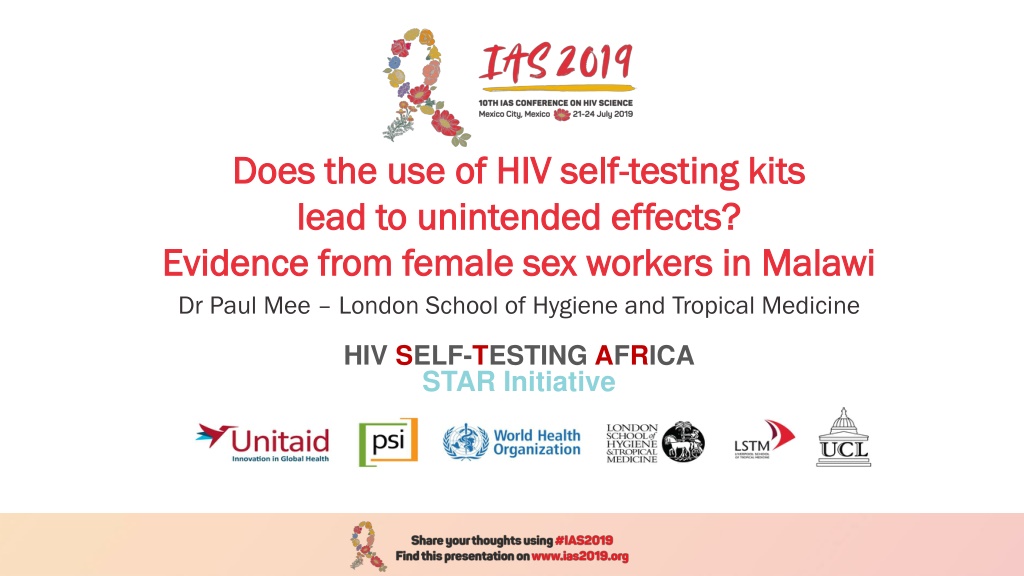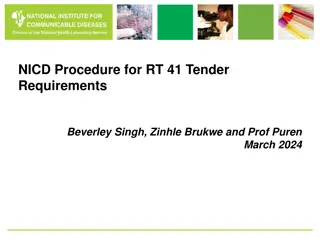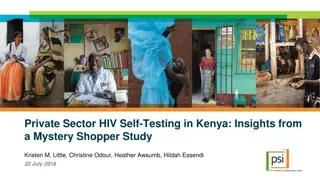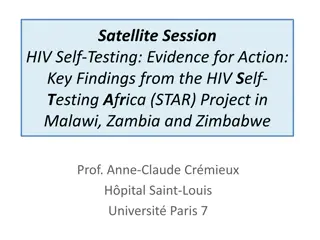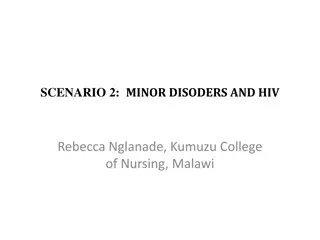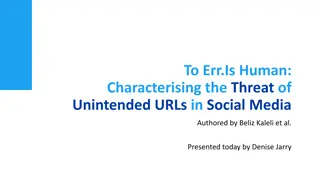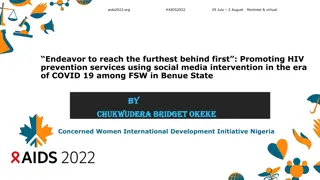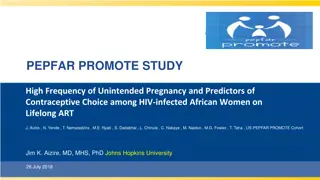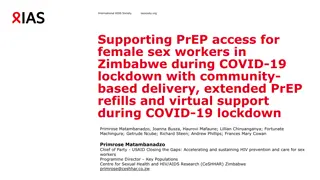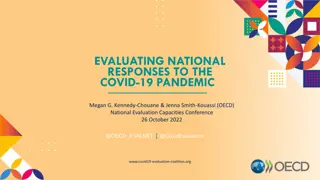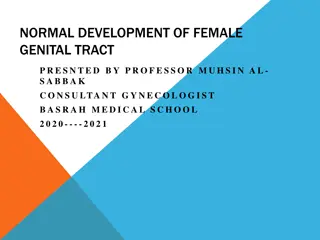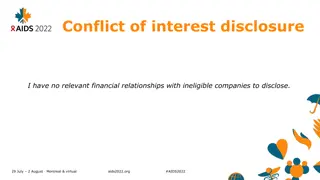Unintended Effects of HIV Self-Testing Kits: Evidence from Female Sex Workers in Malawi
Female sex workers in Malawi were part of a study on the use of HIV self-testing kits, evaluating potential unintended effects such as regret and social harms. The research, led by Dr. Paul Mee from the London School of Hygiene and Tropical Medicine, explored the impact of peer distribution of HIVST kits to this vulnerable group. The study aimed to investigate appropriate HIVST delivery models and monitor for any social harms that may arise. Results from this study provide insights into the safety and acceptability of HIV self-testing in this population.
Download Presentation

Please find below an Image/Link to download the presentation.
The content on the website is provided AS IS for your information and personal use only. It may not be sold, licensed, or shared on other websites without obtaining consent from the author. Download presentation by click this link. If you encounter any issues during the download, it is possible that the publisher has removed the file from their server.
E N D
Presentation Transcript
Does the use of HIV self Does the use of HIV self- -testing kits lead to unintended effects? lead to unintended effects? Evidence from female sex workers in Malawi Evidence from female sex workers in Malawi Dr Paul Mee London School of Hygiene and Tropical Medicine testing kits HIV SELF-TESTING AFRICA STAR Initiative
Competing interests Competing interests The authors declare that they have no competing interests.
What I will cover today What I will cover today Background to the study Summary of research methods and analytical approach Evidence for regret associated with HIVST use Evidence for social harms following HIVST use Conclusions and next steps
Background Background - - HIV Self testing in Female Sex Workers HIV Self testing in Female Sex Workers Worldwide Female Sex Workers (FSW) experience high levels of violence 1 RCTs show HIVST associated with an increased uptake and frequency of testing 2 HIV Self testing (HIVST) - a safe and acceptable alternative to Facility based testing for FSWs in Zambia, Uganda, Kenya & Zimbabwe 3,4,5,6 High readiness for HIVST in the General Population in Malawi preferred to facility based testing 7 Concerns remain about social harms of HIVST amongst vulnerable groups References 1 Deering K.N. et al . AMJPH (2014 ) 2 Johnson CC et al JIAS(2017) 3 Chanda, M.M. et al. PLoS medicine (2017) 4 Ortblad, K. et al. PLoS medicine (2017) 5 Thirumurthy H. et al. Lancet HIV (2016) 6 Napierela et al Bull WHO (in press) 7 Choko A.T. et al PLoS medicine. (2015)
This study This study - - Peer distribution of HIVST to FSW in Malawi Peer distribution of HIVST to FSW in Malawi Research led by the team from the Malawi-Liverpool-Wellcome Trust Clinical Research Programme in Blantyre, Malawi (March December 2017) Part of a programme of studies into HIVST distribution in Malawi (Kumwenda M.K. et al. JIAS 2019) Study goals Investigate appropriate HIVST delivery models among FSW Monitor for potential social harms FSWs recruited as peer distributors 5281 kits distributed , 2001 in Blantyre district Prizes for most successful distributors Participants could receive multiple kits over 3 months Oral Fluid Test HIVST OraQuick ADVANCE (with WHO pre-qualification approval) Study protocol (http://hivstar.lshtm.ac.uk/protocols/)
Data Collected Data Collected For each HIVST recipient T= 0 HIV Self test received Baseline interview Audio Computer Assisted Interviews (ACASI) interview Collected data on socio-demographics, sexual behaviour, testing history , social harms
Data Collected Data Collected For each HIVST recipient T= 0 HIV Self test received Baseline interview Audio Computer Assisted Interviews (ACASI) interview Collected data on socio-demographics, sexual behaviour, testing history , social harms Three month longitudinal diary Daily reports on sexual behavior & social harms Weekly reports on HIV testing
Data Collected Data Collected For each HIVST recipient T= 0 HIV Self test received Baseline interview Audio Computer Assisted Interviews (ACASI) interview Collected data on socio-demographics, sexual behaviour, testing history , social harms T= 3 months Endline interview Repeat ACASI interview Changes in sexual behaviour, testing and occurrences of social harms Three month longitudinal diary Daily reports on sexual behavior & social harms Weekly reports on HIV testing
Analytical Questions from the Analytical Questions from the endline endline data data i. What percentage of participants reported regret about HIVST use or relationship problems associated with HIVST use? ii. Did this differ by socio-demographic characteristics, test result or test initiator?
Characteristics of the study cohort Characteristics of the study cohort Variable Category 16-25 26-35 >36 Primary or less Secondary or higher Total N (%) 151(57.0) 96(36.2) 18(6.8) 170(64.2) 95(35.8) 265 Age Education level High rates of Intimate Partner Violence reported at baseline (48.4%) Data on regrets and relationship problems associated with HIVST use available for 131/265 (49.4 %) This group slightly older than those not reporting this data
Regret and relationship problems amongst those Regret and relationship problems amongst those reporting HIVST use at reporting HIVST use at endline endline Percentage reporting regret about HIVST Relationship problems caused by HIVST use Immediate regret about HIVST use Regret now about HIVST use Variable use was low and decreased over time since test Category Total p-value % p-value % 9.2 9.1 6.7 10.5 16.7 0 8.3 9.2 p-value % 3.4 13.6 8.9 5.8 9.1 3.8 8.3 6.9 Self Other Reactive Unreactive 87 44 45 86 66 53 12 131 12.6 22.7 15.6 16.3 18.2 11.3 25 16.0 Test initiator 0.20 1.0 0.06 HIVST result 1.00 0.54 0.25 16-25 26-35 >36 Age in years 0.40 < 0.01 0.51 Total - - -
ACASI results III ACASI results III regret and relationship problems regret and relationship problems amongst those reporting HIVST use at amongst those reporting HIVST use at endline endline Evidence that relationship problems were greater if someone else initiated the HIVST (mainly peer distributors) Relationship problems caused by HIVST Immediate regret about HIVST Regret now about HIVST Variable Category Total p-value % p-value % 9.2 9.1 6.7 10.5 16.7 0 8.3 9.2 p-value % 3.4 13.6 8.9 5.8 9.1 3.8 8.3 6.9 Self Other Reactive Unreactive 87 44 45 86 66 53 12 131 12.6 22.7 15.6 16.3 18.2 11.3 25 16.0 Test initiator 0.20 1.0 0.06 HIVST result 1.00 0.54 0.25 16-25 26-35 >36 Age in years 0.40 < 0.01 0.51 Total - - -
ACASI results III ACASI results III regret and relationship problems regret and relationship problems amongst those reporting HIVST use at amongst those reporting HIVST use at endline endline No evidence that regret or relationship problems were associated with HIVST Relationship problems caused by HIVST Immediate regret about HIVST Regret now about HIVST Variable result Category Total p-value % p-value % 9.2 9.1 6.7 10.5 16.7 0 8.3 9.2 p-value % 3.4 13.6 8.9 5.8 9.1 3.8 8.3 6.9 Self Other Reactive Unreactive 87 44 45 86 66 53 12 131 12.6 22.7 15.6 16.3 18.2 11.3 25 16.0 Test initiator 0.20 1.0 0.06 HIVST result 1.00 0.54 0.25 16-25 26-35 >36 Age in years 0.40 < 0.01 0.51 Total - - -
Longitudinal diary Longitudinal diary Weekly reports of HIV self and facility based testing and coercion to test or disclose test result Daily reports of type of sexual partners , condom use and social harms per partner
Longitudinal diary data Longitudinal diary data
Longitudinal diary data Longitudinal diary data Analytical Questions i) What evidence is there that social harms are more likely in the week of a test and the following week compared to weeks where no tests occur and following week? ii) Is there evidence that this differs between self tests and facility based tests?
Results of GEE analysis Including all individuals with baseline ACASI data (n=222) Multivariate model using Generalised Estimating Equations (GEE) to account for correlated data within individuals and over time Some evidence for increase in reports of verbal abuse in week of HIVST and following week Adjusted 1 odds ratio (95%CI) For occurrence of social harm in week of test and following week compared to weeks with no test and following week Type of social harm Any test Clinic Test only Self Test only 1.22 (0.90 1.66) 1.32 (0.76 2.29) Verbal 1.42 (0.98 2.07) 1.07 (0.76 1.49) 0.84 (0.43 1.63) Physical 1.27 (0.84 1.91) 1.02 (0.72 1.43) 0.94 (0.49 1.79) Sexual 1.16 (0.76 1.77) 0.95 (0.70 1.31) 1.23 (0.71 2.15) Economic 0.91 (0.61 1.36) 1 Adjusted for total sex encounters per week, age and self identification as sex worker
Summary and Conclusions Summary and Conclusions Peer distribution strategy effective in reaching FSW with HIVST Percentage of FSW reporting regret about taking HIVST was low and decreased over time Regret not associated with test result Further qualitative analysis probing meaning behind regret Relationship problems more likely to be reported if test initiated by another person (mainly peer distributor) Therefore important to consider alternative models to peer distributors for HIVST distribution among FSW Some evidence in this small study population for increase in reports of verbal abuse following HIVST use for peer distribution model Based on this and other studies It is important to consider HIVST as an alternative where safe, acceptable and effective for reaching PLHIV in key at risk populations
Acknowledgements Acknowledgements Study participants STAR project funders - Unitaid Co-authors - Melissa Neuman1, Moses Kumwenda2, Mwiza Sambo2, Wezzie Lora 2 ,Pitchaya Indravudh1,2, Karin Hatzold3, Cheryl Johnson4, Liz Corbett1,2, Nicola Desmond2 1London School of Hygiene and Tropical Medicine, UK 2 Malawi-Liverpool Wellcome Trust Clinical Research Programme, Blantyre, Malawi 3Population Services International, Johannesburg, South Africa 4 Department of HIV/AIDS, WHO Geneva, Switzerland paul.mee@lshtm.ac.uk
